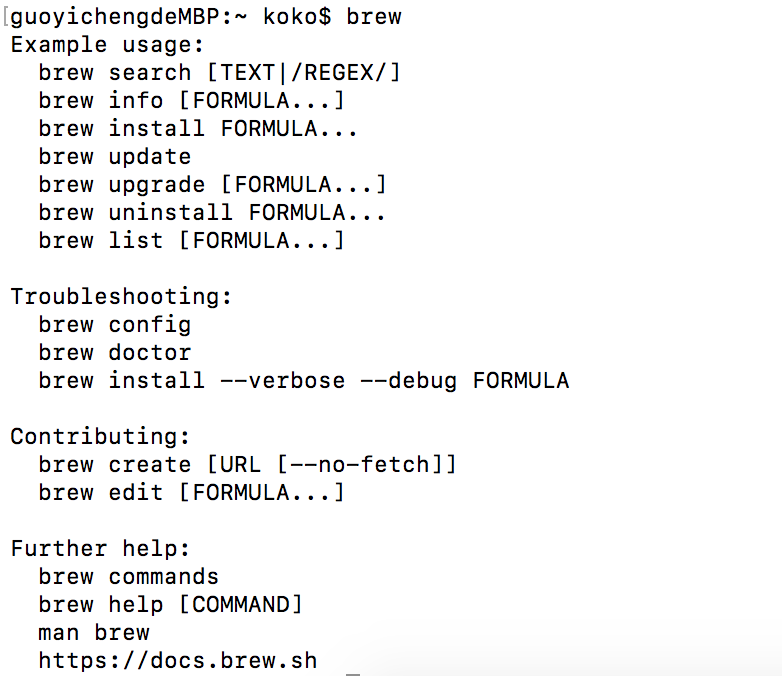Homebrew is an open-source package manager for macOS that offers an easy way to install software and tolls through the command line. If you are a coder, developer, Terminal lover, or more tech-savvy than an average Mac user, you can use Homebrew to simplify software installation on your Mac.
19 Dec 2020After reading all the raving reviews online about the new Apple M1-based Mac computers, and after losing too much time with my overheating MacBook Pro 2013 that’s on its last legs, I caved and bought a Mac Mini M1.


☑️ Apple 30″ Cinema display (2013)
Homebrew Imagemagick Superenv build fail. GitHub Gist: instantly share code, notes, and snippets. Convert is an ImageMagick command, so I'd say it's safe to just do brew link -overwrite imagemagick. If you want to be overly cautious, you can do brew link -overwrite -dry-run imagemagick to have a look at the list of overwritten files first, but I'd say that's not necessary. – 4ae1e1 Mar 21 '15 at 16:36. Homebrew complements macOS (or your Linux system). Install your RubyGems with gem and their dependencies with brew. “To install, drag this icon” no more. Homebrew Cask installs macOS apps, fonts and plugins and other non-open source software. $ brew install-cask firefox.
I made the mistake of thinking that any USB hub with a Mini Displayport connector would work with my Cinema display. But apparently, not all such ports are also Thunderbolt 2, as I found out with my Satechi hub.. Fortunately, Apple sells a 55 euro Thunderbolt 3 (with USB-C connector) to Thunderbolt 2 (with mini Displayport connector), and it works perfectly. This already takes 1 of the 2 USB-C ports on the Mac Mini.
☑️ Homebrew in native mode
I do a lot of bash/script development so my first concern was getting all of my bash scripts working on the new ARM architecture. I concentrated on bash/terminal in native arm64 mode, which means not running under Rosetta2. This because I want to benchmark in native mode, and I kind of assume that under Rosetta 2 everything works that worked under MacOS for Intel, and where’s the fun in that?
For that, I needed to get the Homebrew package manager running in native mode. The thing is, Homebrew does not yet support the new Apple Silicon M1 chip (they only started the first steps in Dec 2020), so you have to dodge all the warnings they throw at you. After someresearch, I found the best way to do it, and I combined all of it in an easy install/uninstall bash script:** https://github.com/pforret/m1_homebrew** It installs the command-line tools and Homebrew to /opt/homebrew for arm64 mode, and to /usr/local for standard i386 mode.

Running it is as easy as:
🤞 brew install –build-from-source
After installation, running brew install will give you warnings and will often not be able to install the packages, because there are no pre-built casks for Apple Silicon yet.
Imagemagick Download For Windows 10
Still, you can tell brew to install from source code, and compile on your machine by using brew install --build-from-source (or shorter: brew install -s). For small packages like awk, this will do the job. For large packages with lots of dependencies like ffmpeg, brew will stop for lack of bottles.
☑️ native imagemagick

My first big package to install was imagemagick. It’s my go-to tool for image manipulation and part of many of my scripts like e.g. splashmark. Imagemagick has lots of brew dependencies for treating different kinds of files, like libpng, openjpeg, webp and ghostscript. Every time brew requires a package that isn’t installed yet, it stops with the error mentioned above. You then have to build that package separately and try the original brew install again. This is how I got imagemagick compiled in the end.
☑️ m1_homebrew recursive
I automated this process in the same script m1_homebrew.sh. m1_homebrew recursive imagemagick first looks for all the dependent packages (via brew info), installs those first one by one and then, at the end, installs the main package. It can take a long time but it’s magic when it works.
😥 no native ffmpeg
Unfortunately, it doesn’t always work. I tried it for ffmpeg, but this package requires some dependencies that will not build on MacOS M1 for now. Concretely: rust and openjdk cannot be built yet, and ffmpeg requires them.
- rust: hangs on “
arch -x86_64 make” which implies that it’s building a x86_64 (Intel) version instead of a arm64 native version, - openjdk: “configure: The tested number of bits in the target (64) differs from the number of bits expected to be found in the target (32)“
Homebrew Imagemagick

They are both still marked as ⚠️ on the official Homebrew M1 compatibility list.
Recent Posts
Homebrew Imagemagick Osx
Generate individual tag/category/author pages for your Jekyll websiteI’ve been migrating more and more of my websites to Jekyll static sites, from Wordpress. The advantages are clear:
| My disaster upgrade to LastPass PremiumLastPass has started pushing its free users towards a paid premium subscription. The way they do this is by only allowing the free version for 1 platform, e.g. only your... • 18 Mar 2021 | Detecting excessive SSD wear on Apple Silicon M1 machines
|
